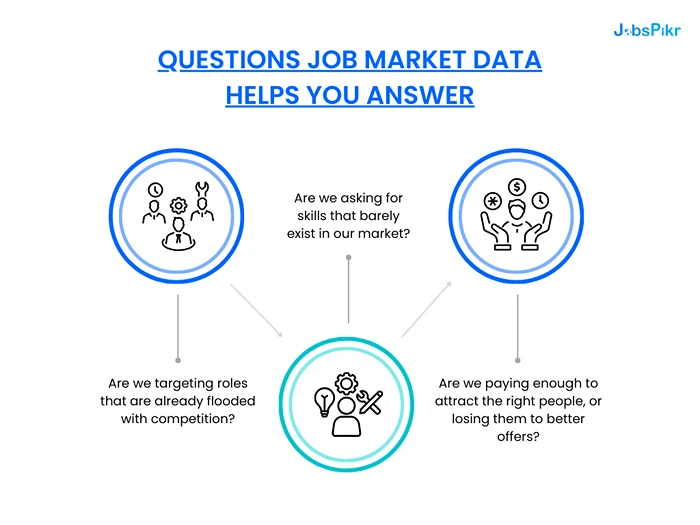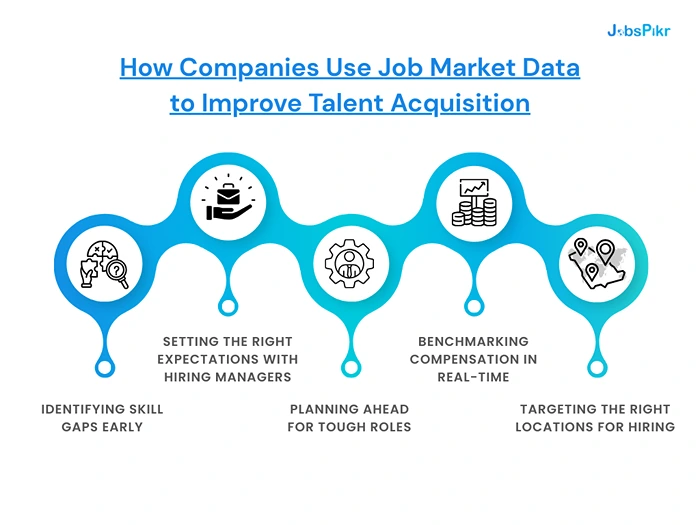Hiring today isn’t about posting a job and hoping the right people apply. There’s way too much noise and too many moving parts. If you want to hire smart, you need to know what’s actually going on in the job market, not just inside your company, but out in the real world. That’s where job market data comes in.
Job market data is a live snapshot of who’s hiring, what roles are in demand, what skills are trending, and where the biggest gaps are. It shows you which companies are hiring for what, how long it’s taking them to fill roles, what salaries are being offered, and even which skills are popping up more often in job descriptions.
It’s not just about trends. It’s about seeing where the market is heading so you can plan ahead, not react too late.
And when you zoom out a bit, labor market data adds another layer. It gives you context: unemployment rates, participation rates, and shifts in labor supply. This isn’t abstract economic stuff; it directly affects your hiring pipeline. If participation in your industry is dropping, that means your talent pool is shrinking. You need to know that before it hits your time-to-hire metrics.

This kind of information helps you stop guessing. It helps you answer questions like:
- Are we targeting roles that are already flooded with competition?
- Are we asking for skills that barely exist in our market?
- Are we paying enough to attract the right people, or losing them to better offers?
If your team is still relying on gut instinct or last year’s hiring plan, you’re already behind.
The Strategic Advantage of Using Job and Labor Market Data in Hiring
Hiring is expensive. It’s also time-consuming. And when you get it wrong, when you hire too late, for the wrong role, or with the wrong offer, it can set entire teams back. That’s why more companies are turning to job market data and labor market data to guide how they hire, not just who they hire.
Here’s the thing: most hiring mistakes come down to bad timing, poor understanding of the market, or outdated assumptions about talent availability. Job data gives you real-time visibility into what’s happening across your industry. Instead of relying on quarterly reports or internal guesswork, you can base your hiring strategy on live trends.
Let’s say you’re building a team of product designers. You’ve got budget, you’ve got approval, and you think it’ll be simple. But the market shows something different — demand for product designers is up 60% in your region in the past three months. Salaries are rising. Roles are staying open longer. If you don’t move fast, or if your comp package is weak, you’re going to lose out.
That kind of insight changes how you plan. You might fast-track recruiting, adjust your salary bands, or open up to remote candidates. Without that data, you’re flying blind.
This isn’t about being reactive. It’s about getting ahead. When you know what’s happening in the labor market, you can:
- Prioritize roles based on demand and difficulty
- Identify emerging skill sets before they become common
- Build competitive offers grounded in real-world benchmarks
- Spot hiring slowdowns or shifts before they hit your metrics
And this isn’t limited to big tech firms with fancy analytics teams. More tools and platforms now make labor market data accessible to any HR or TA team that’s willing to use it — and JobsPikr is one of those solutions (more on that later).
Bottom line: Hiring without job data today is like setting sail without checking the weather. You might get lucky, but it’s not a strategy.
How Companies Use Job Market Data to Improve Talent Acquisition

Let’s be honest — talent acquisition is under pressure. Everyone wants results: faster hiring, better candidates, lower costs. But without the right inputs, even the best recruiters are just guessing. That’s where job market data makes a real difference. It gives you the context to build smarter strategies, not just react to hiring requests.
So, how are companies actually using this data?
1. Identifying Skill Gaps Early
You don’t want to realize you’re missing a key skill only after a project falls behind. Smart hiring teams use job data to see what skills are in demand across their industry — and compare that with their internal talent. If your competitors are hiring cloud security experts and you’re not, that’s a red flag. It might mean you’re falling behind, or worse, you’re blind to a shift in your market.
2. Setting the Right Expectations with Hiring Managers
There’s always that moment: a hiring manager wants a unicorn — five years of experience in a niche skill, three languages, and leadership experience — all at a mid-level salary. Job data helps you push back with facts. You can show that candidates with that profile are rare, highly paid, and mostly based in cities you’re not hiring in. Suddenly, the job description gets more realistic.
3. Planning Ahead for Tough Roles
If you know certain roles have long time-to-fill metrics, you can start sourcing earlier. You can also build a talent pipeline before the role opens. No more panic recruiting. Job data lets you spot hiring friction points before they become a problem.
4. Benchmarking Compensation in Real-Time
Salary benchmarks that are six months old? That’s not helpful. The market moves fast, especially in tech and healthcare. Job market data can show you what companies are offering right now — not just in job ads, but across locations and levels. You can use that to shape your offers and stop losing candidates to better-paying competitors.
5. Targeting the Right Locations for Hiring
Remote work opened up the hiring map. Now you can look beyond your city, but where should you focus? Job and labor market data help you find cities with strong candidate pools, lower competition, and better costs. It’s not about guessing. It’s about targeting the right talent markets based on evidence.
So, this isn’t just data for reporting. It’s data that shapes real hiring decisions — the kind that moves the needle.
How Labor Market Data Software Streamlines Recruitment Analytics

Using job market data manually is a pain. Scrolling through hundreds of job ads, trying to track trends, pulling together salary data from multiple sources — it’s not just time-consuming, it’s prone to error. This is where labor market data software steps in to simplify the process and make it all more accurate and actionable.
These tools turn raw job data into something actionable. Instead of spending hours piecing together insights, you get a clear picture of what’s happening in real-time.
1. Automating Data Collection
Labor market data software automates the data-gathering process. It scrapes thousands of job postings, salary reports, and other key data points in seconds, then compiles it into useful, digestible reports. No need to waste time on manual searches — just let the software bring the insights to you.
2. Analyzing Trends and Spotting Patterns
Once the data’s collected, the software does the heavy lifting. It analyzes job trends, skill gaps, and salary movements over time. You can look at everything from national patterns to hyper-local insights — whatever’s most relevant to your company. This lets you spot hiring trends early and make proactive decisions. Want to know when demand for a specific role starts spiking? The software tells you before it becomes a problem.
3. Real-Time Market Insights
One of the biggest advantages of using software is that it gives you real-time data. Job market conditions can change quickly. By the time you notice a trend manually, you could already be behind. Labor market software provides up-to-date insights, which means you’re always working with the freshest information.
4. Custom Reports and Dashboards
Rather than relying on static, generic reports, you can customize the software to pull exactly what you need, whether that’s salary benchmarks for a particular role, time-to-fill stats, or a deep dive into skill sets across industries. It’s like having a personal analyst at your fingertips, ready to serve up the insights you need, when you need them.
Labor market data software doesn’t just save time. It turns a complex process into something simple and actionable. With the right tools, you can manage your hiring strategy with confidence — no guesswork involved.
Real-World Use Cases of Job Market Data in Hiring
Let’s take everything we’ve covered so far and see how companies are actually using job market data in real life. This is where the rubber meets the road.
1. A Tech Company Finding Talent for a Niche Role
A tech company needed to fill a specialized role — think cloud architect with expertise in machine learning. The hiring manager thought it would be straightforward. But when they looked at the job market data, they saw the role had exploded in demand. Every other tech company was hunting for the same talent, and the salary expectations had shot up by 20% in just six months.
Thanks to job market data, the company adjusted its strategy. They increased the salary offering, expanded their search to include remote candidates, and focused more on transferable skills instead of exact experience. The role was filled within a month — a huge win compared to the 4-5 months it would have taken without that insight.
2. A Retailer Planning for Seasonal Hiring
A major retail chain needed to hire hundreds of seasonal workers for the holiday rush. Traditionally, they’d put out job ads and hope for the best. But this time, they used labor market data to forecast where the highest demand for seasonal workers would be. They learned that in some regions, the candidate pool had already been drained by other retailers, while in others, they had untapped pools of workers.
Armed with this data, they adjusted their hiring strategy, opening up recruitment in areas where demand was low and salaries were competitive. The result? They filled all positions on time and reduced turnover.
3. A Healthcare Provider Adjusting for Talent Shortages
A healthcare provider was struggling to fill critical nursing positions, despite posting job ads regularly. By analyzing job market and labor market data, they discovered that there was a widespread shortage of nurses in their region. They also found that hospitals in neighboring cities were offering sign-on bonuses to attract talent.
Instead of continuing to put up ads with the same offer, they decided to incorporate a retention bonus and an improved benefits package. They also tapped into out-of-state recruitment by offering relocation assistance. Within weeks, they saw a 30% increase in qualified applicants.
These are just a few examples of how companies are using job market data to stay competitive and make smarter hiring decisions. Instead of relying on guesswork or outdated methods, they’re turning real-time data into strategic advantages.
JobsPikr — Your Source for Reliable Labor Market Intelligence
When it comes to hiring the right talent, having the right data makes all the difference. That’s where JobsPikr steps in. We specialize in providing reliable job market data that helps businesses make smarter, data-driven hiring decisions.
Why Should You Use JobsPikr?
JobsPikr gives you access to real-time labor market data from across the web. It pulls insights from job postings, salary trends, and skill demands so you can stay ahead of the curve. Whether you’re looking to see what skills are in demand or adjusting your salary offers to stay competitive, you get the data you need without the hassle.
How JobsPikr Helps You Hire Smarter
Using job market data isn’t just about collecting numbers. It’s about knowing how to use them to make informed decisions. With JobsPikr, you can:
- Spot where there are skill gaps in the market
- Understand salary trends in your industry
- Focus your recruiting efforts where the demand is growing
This means no more guessing. You’re making hiring decisions based on solid data, not assumptions.
Easy-to-Use Reports
Getting data should be easy, not complicated. With JobsPikr, you get reports that focus on the exact data you need. Want to know the average salary for a particular role in a specific region? Or maybe you want to know what skills are most in demand in your industry? It’s all there, ready for you in just a few clicks.
Actionable Insights to Drive Hiring Decisions
The best part? JobsPikr doesn’t just provide data; it gives you actionable insights. This means you can look at job market trends and immediately understand how to adjust your hiring strategy. Whether it’s fine-tuning your compensation packages or shifting focus to an emerging talent pool, you can act on what the data tells you right away.
Schedule a demo with us today, and let us show you how JobsPikr can help you make smarter hiring decisions with the most up-to-date, reliable job market data.




